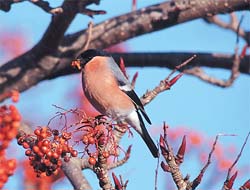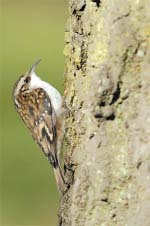 |
Mixed
fortunes for Dalkey’s birdlife this year. For the first year since
our involvement in the tern colony at Dalkey Sound no birds produced chicks.
They had been slow to begin nesting but by early June there were about
twenty nests of mostly Common and a few pairs of Arctic Terns as well as
one pair of the much rarer Roseate Tern on Maidens Rock (the outcrop of
rock furthest left from Dalkey Island) while at least six pairs of Arctic
Terns nested behind the fence on Lamb (the western part of Dalkey Island
separated at low tide). The Roseates terns had occupied a nestbox we’d
put out a few weeks before and a bird was always visible sitting in it.
The Roseate was sitting on two eggs and although the colony had smaller
numbers then previous years, all was looking well. We were having that
heat spell in the first week in June. A few days of sunshine and you begin
to think it’ll last forever but weatherman had said that it was going
to end by the |
weekend
and gradually the forecast started getting direr until they were forecasting
North Easterly gales. North easterly seas are the only ones that affect
the terns on Maidens since the seas will crash right over the rock and
far too many times in the past all the nests and many tern chicks have
been washed off.
This time, to add to the threat, there was going to be a full moon at the
weekend so the tides would be at their highest. The colony of Little Terns
on the beach in Newcastle in Wicklow also suffers from the same storms
and three quarters of the nests down there were destroyed despite valiant
efforts by the wardens who even took clutches of eggs and put them on hot
water bottles to keep them warm while the storm blew. Back in Dalkey our
worst fears came through and after a day of high winds, crashing waves
and torrential rain all the birds were gone off Maidens Rock. This time
unlike previous years when they’d been washed off but then came back
and nested again there was no sign of them returning. Our hopes were raised
about three weeks later when a number of birds were back mating on the
rock and looking like they might try nesting again but they came and went
and didn’t stay on nests and by mid July any chance of them successfully
nesting and rearing chicks were negligible.
Meanwhile the half dozen Arctic tern nests on Lamb Island had survived
the bad weather and for a while it looked like they might succeed but whether
it was disturbance by goats or people walking across the island they too
deserted their nests in late June. Since we’d became involved in
the Tern project 14 years ago this will be our first season with no chicks
hatched which is sad and very disappointing to all involved. Closer to
home this spring was the first I can remember when we didn’t have
a Song Thrush singing near our garden, proclaiming a territory. Although
lots of Blackbirds were singing the evenings weren’t the same without
the Song Thrush, one of our most melodic songsters and often the last bird
singing on long summer evenings. Song Thrushes are in decline everywhere
especially in the UK and Ireland. No one is exactly sure why their numbers
are dropping although their habit of nesting low in bushes and mostly feeding
on the ground makes them very vulnerable to predation by cats. But it wasn’t
all bad news. As I mentioned last month the ravens nested and successfully
reared 3 or 4 chicks.
We were delighted in June to come upon a family of Jays, the juveniles
evidently recently having left the nest since one was hopping around barely
able to fly. Although I’d seen Jays making a nest last year on Killiney
Hill I didn’t see any young then so this could possibly be the first
year Jays have become breeding birds on the hill, a very welcome addition.
There were at least six Blackcaps singing and holding territory on Dalkey
and Killiney hill and at least one pair fledged young. Bullfinches as a
species are doing well in Ireland and there’s a good healthy population
on the hills. Very colourful but quite secretive, these delightful little
birds are more often noticed by their call, a single plaintive note. We
came upon at least two family groups this year and had seen adults everywhere,
once feeding on elm tree seeds. We’d seen one pair of Treecreepers
nesting, conveniently for us to watch, in a little hole in a tree just
beside the path.
| Later
in the summer we came upon another busy family of Treecreepers, a parent
bird bringing food to the young and as we watched a young bird landed
on the opposite side of a small tree my companion was leaning against,
literally a few inches away from her head. Linnets were singing from
a few different spots this year, one above the gorse above Vico Road
and another one near the Obelisk but I don’t know if they nested
successfully. Goldcrests, our smallest bird, are very common but again
not so easily seen. In early July I nearly stood on one in our garden
where it was crouched motionless on a path. I’d thought at first
it was a leaf or little clump of moss and nearly kicked it out of the
way then saw it was a juvenile Goldcrest. Not long out of the nest it
hadn’t developed the little crown stripe that gives them their
name and the poor little thing had evidently got separated from it’s
family. We kept it in a box for a while till we were sure it could fly
and wasn’t in shock then placed it in a conifer hedge where Goldcrests
often move through. We hoped it might make contact with its family again
but didn’t hold out too much hope. I’d been getting worried
about our Sparrowhawks. Almost every year two pairs nest and successful
breeding is confirmed, nearly always in the second week in July, by
the sharpcalls
of young |
 |
sparrowhawks
telling their parents where they are and telling mum and dad they could
do with some food. Sure enough on the 12th July there was one calling
and I hope I’ll be hearing a lot more calls. At time of writing
I’m worried about the other pair. They’d nested near a area
that subsequently became very busy with teenagers constantly hanging
out nearby and I’m afraid the disturbance might have scared off
the birds. But I’ll live in hope since, as I mentioned before,
a pair used nest on Killiney hill on a tree a few feet from a path and
they still managed to raise young.
On humid windless days in July and August you might notice the sky filled
with birds whirling around and making short swooping dives. These are
Black Headed Gulls and they’re feeding on ants, young female ‘princesses’
and male ants which have just taken to the air. The female ants have
set off to start new nests and when they’ve settled into a suitable
place they’ll remove their own wings and start laying eggs. That’s
if the birds don’t get them first! The rocks near the top of Dalkey
hill and near the Obelisk on Killiney hill are often a good place
to see Grayling butterflies. Although not the most colourful of butterflies
it has a fascinating method of camouflaging itself from predators. When
it lands on granite rocks its prominent underwings almost match the
patterns of the rock. Then it tucks in its forewing. Then, so that it
doesn’t cast a shadow it gradually leans over until it’s
almost flat against the rock. At that stage it’s practically invisible.
Graylings will be on the wing in August and sunny days in early autumn.
www.irishbutterflies.com
is a very good website for details on Irish butterflies
and where and when to see them. |
|
|



